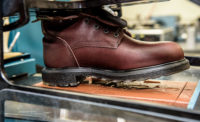The majority of OSHA citations regarding foot protection call for ANSI-approved safety-toed footwear. Approval is tied to the ability to resist compression and impact. The safety toes are commonly made of steel, but a new composite material has been approved. Employees may balk at wearing the shoes, complaining that they will be uncomfortable. But with the correct fit and suitable socks, there shouldn't be any significant problem. ANSI-approved foot guards can be worn over conventional footwear, but special diligence must be used to ensure that there are no attendant tripping hazards.
Judgement call
In considering whether to cite, OSHA must exercise professional judgement in its decision-making process. For instance, there is no specific criteria as to the weight of an object that might reasonably fall or roll onto one's foot. Note that a 50-pound bag of liquid or powder being carried might be dropped onto a foot with little, if any, physical damage being caused. The material might be dispersed in a relatively innocuous manner, or the bag might break.The usual background for citation involves the carrying of dense metal parts. The hazard is exacerbated when the article has sharp surface(s). There is also an added hazard when the item is somewhat slippery - a condition often resulting from lubrication. Be mindful, too, of the increased potential for dropping the item when there are no properly fashioned grips or no "designed-in" portions to easily grasp. Such parts as chuck lathes, press dies and tooling fixtures are but three examples of "culprits" generally leading to citation. There is also the hazard of objects such as nails piercing the sole of the shoe, in which case OSHA's main focus is not on the toes but on a special metal bottom on the interior of the footwear.
One OSHA study indicated that the typical foot injury was caused by objects falling less than four feet and the median weight was about 65 pounds. In my experience, OSHA citations have been based on objects weighing far less. However, with especially heavy items, and regular exposure anticipated, OSHA will cite, albeit infrequently, for the lack of metatarsal protection. This is most typically done for foundry operations. Once again, over-the-shoe appliances are available.
Various hazards
OSHA standards recognize the need for foot protection for other types of hazards. Some examples of those injury sources include molten metal, hot surfaces, vapor ignition, wet/slippery floors and similar footing surfaces, acids/corrosives and electrical current.
There are special types of footwear designed to protect against such hazards - either for the particular hazard or for a combination of the hazards. At times, suitably impervious boots, or spats, are needed to preclude hot or corrosive substances (or welding sparks) from contacting the skin. If the threat of dangerous chemical splash exists and spats are not used, then pants should be worn over the boots. Tucking the pant legs into the boots may leave an opening that could result in the footwear becoming a receptacle for the harmful substance.
